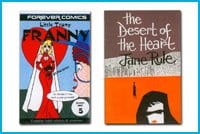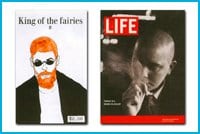
BENT BOOKLIST. Just a few of the titles on display at the Queer CanLit exhibit.
Look up in U of T’s Thomas Fisher Rare Book Library and you can see floors and floors of bookshelves, specially lit to preserve the books. While not usually on the map as one of Toronto’s queer hangouts, this summer the library is hosting the exhibit Queer CanLit: Canadian Lesbian, Gay, Bisexual and Transgender Literature in English, curated by Scott Rayter, Donald W McLeod and Maureen FitzGerald, and cosponsored by the Mark S Bonham Centre for Sexual Diversity Studies.
For the aficionado of queer Canadian literature the exhibit, which runs until Fri, Aug 29, is a welcome overview of both familiar names and a few surprises, including the 1942 poem “Drinker” which alludes to a blowjob. It covers works of fiction, including Derek McCormack’s The Haunted Hillbilly and Eve Zaremba’s A Reason to Kill, which was the first lesbian mystery novel published in Canada; Erin Mouré’s poetry; Sky Gilbert’s plays; and a collection of zines borrowed from the Canadian Lesbian and Gay Archives (CLGA) including some dedicated to bad-boy fiddler Ashley MacIsaac. While it only covers works in English the exhibit does include some translations of French works such as those by Nicole Brossard and Michel Tremblay.
Rayter, who currently teaches in English and sexual diversity studies at U of T, says the exhibit will help to bring Canada’s queer lit to the forefront — something he says is long overdue.
“I did a lot of Can lit as an undergrad and was surprised at how much queer stuff I came across in certain texts, but no one seemed to talk about it,” says Rayter. “One of the arguments I make in the catalogue is that it wasn’t simply about trying to include works that were missing or overlooked, but the way in which some really canonical texts are read in ways that ignore or minimize, and indeed outright reject queer issues, thematics and readings.”
“Can lit in general was very much a boys’ club up until the 1970s or so and the publishing of what could be called ‘queer’ titles was no exception,” says McLeod, acquisitions coordinator at U of T’s Robarts Library and a longtime volunteer at the CLGA. “Our pioneers section [which includes works published up to 1975] for example lists three women and 17 men and all people listed were white. If you look at the rest of the material in the exhibition you will see much more diversity in gender, in race and so on. Since the 1980s everything has changed,” says McLeod, referring to works from familiar writers including Wayson Choy, Ann-Marie MacDonald, Dionne Brand, Trish Salah and Tomson Highway.
All three curators emphasize the importance of publishers, especially small presses, in the development of queer Can lit.
“[Small publishers] facilitated unknown, sometimes previously unpublished, writers to get their work in print,” says FitzGerald, who was the managing editor of the Women’s Press in the 1980s. “There was as a result a flourishing of lesbian publishing, much of it in anthologies, even before gay publishing became more accepted.”
But as Rayter points out “presses for queer publishing have a really difficult time staying afloat. The loss of Press Gang, Sister Vision and, for a while there, Women’s Press is a huge blow. Some of the work they’ve put out will have no other venue. It’s that simple.”
Although FitzGerald tactfully declines to choose a favourite piece she admits, “It is wonderful to see books… that I worked on by authors who I admire and who I feel need to be better known, for example Beth Brant, Ingrid MacDonald, Audrey — now Alec — Butler.”
McLeod shows his archival roots with his pick of the bunch: issue number five of Toronto Rag, a zine published in 1981, which he describes as “a gay memory scrapbook from a particular time in Toronto’s pre-AIDS history…. tall, anarchic, with that early 1980s punk-new wave-art school look.”
Rayter points out the continuing outrageousness of works like Leonard Cohen’s Beautiful Losers, which “still offends and shocks. Considering it’s from 1966, when I taught it a few years ago a number of students told me they didn’t think they could finish reading it, that they were really bothered by it.”
The downside to the exhibit is that the books are confined to glass cases so you can’t flip through them on the spot, although the curators have chosen to display some of the earlier works lying open. Even the covers are revealing, reflecting design trends of the times — check out the cover of Jane Rule’s Desert of the Heart or Marie-Claire Blais’s Nights in the Underground for a blast from the past.
Also on display is a spot-on parody of Life magazine by Shawna Dempsey and Lorrie Millan. Elsewhere Scott Symon’s Combat Journal for Place d’Armes offers a cruising map of Montreal. The exhibit is accompanied by some beautiful black and white photographs of authors by Robert Giard, as well as portraits from the CLGA National Portrait Collection.
And what about the future of queer lit in Canada? “As long as our issues are out there,” says Rayter, “[as long as] our sex lives are different from others and important to us in ways straight folks just don’t get, there will always be a need for that literature.”The Queer CanLit exhibit is on display at the Thomas Fisher Rare Book Library (120 St George St) until Wed, Aug 29.

 Why you can trust Xtra
Why you can trust Xtra


